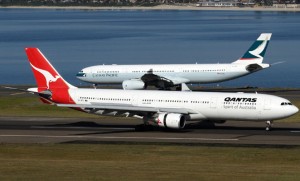
A rare computer fault caused the sudden nose dive of a Qantas flight in 2008 that injured 119 people, an investigation by the Australian Transport Safety Bureau has concluded.
The incident occurred on board Airbus A330-303 VH-QPA operating QF72 that departed Singapore for Perth on October 7 2008. While cruising at 37,000ft, one of the aircraft’s three air data inertial reference units (ADIRUs) began outputting spikes of incorrect values including erroneous angle of attack data. Minutes later, primary flight computers initiated a pair of dramatic, uncommanded dives.
Though lasting only a few seconds, the dives hurled unrestrained passengers against the ceiling and overhead bins, injuring 110 of 303 passengers and nine of 12 crew members. After regaining control of the aircraft, pilots declared a MAYDAY and made an emergency landing at Learmonth Airport, where the flight was met by the Royal Flying Doctors Service and CareFlight. Fourteen people were airlifted to Perth for hospitalisation.
The ATSB investigation found that the computer algorithm for processing angle of attack data, while generally effective, was unable to manage multiple spikes in the data over a short span.
“The occurrence was the only known example where this design limitation led to a pitch-down command in over 28 million flight hours on A330/A340 aircraft, and the aircraft manufacturer subsequently redesigned the angle of attack algorithm to prevent this type of accident from occurring again,” the report said.
However, the investigation did not determine what led the ADIRU to spit out the incorrect data in the first place, concluding only that the spikes were likely initiated by a “rare type of internal or external trigger event.”
Speculation has long centred on interference from nearby Naval Communication Station Harold E. Holt as a possible culprit, especially after a second Qantas flight suffered an ADIRU malfunction in the same area in December 2008. However, the ATSB investigation concluded that the station’s very low frequency radio transmissions were “unlikely” to have played a role “based on multiple sources of information.”
Not surprisingly, the investigation concluded that passengers who were not wearing their seat belts were substantially more likely to have been injured in the incident than those who were. At least 60 passengers were seated without their seat belts on when the first pitch-down occurred.
The investigation found that younger passengers were less likely than older passengers to have been wearing their seat belts, with 38 per cent of those between the ages of 18-30 strapped in compared to 65 per cent of passengers aged 46-60 and 69 per cent of those 60 and older. Asian passengers were also less likely to have been wearing their seat belt than those from Australia and Europe, the report found.
“The report is a timely reminder for passengers to fasten their seatbelts during flight,” the ATSB said in a statement.















